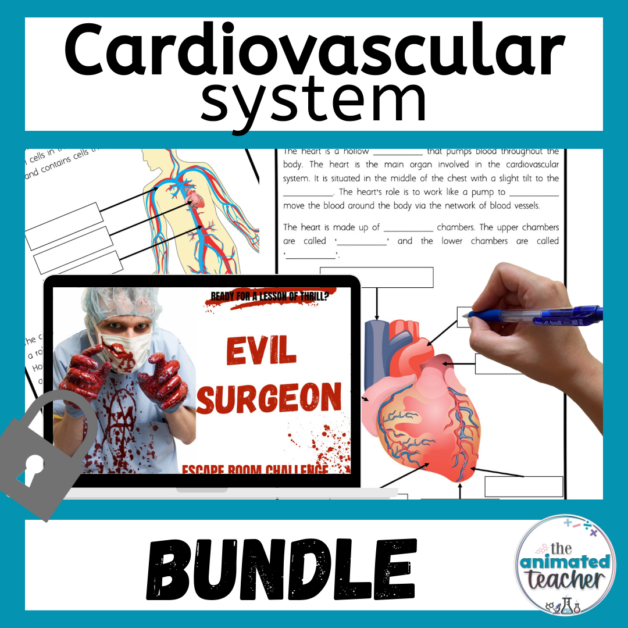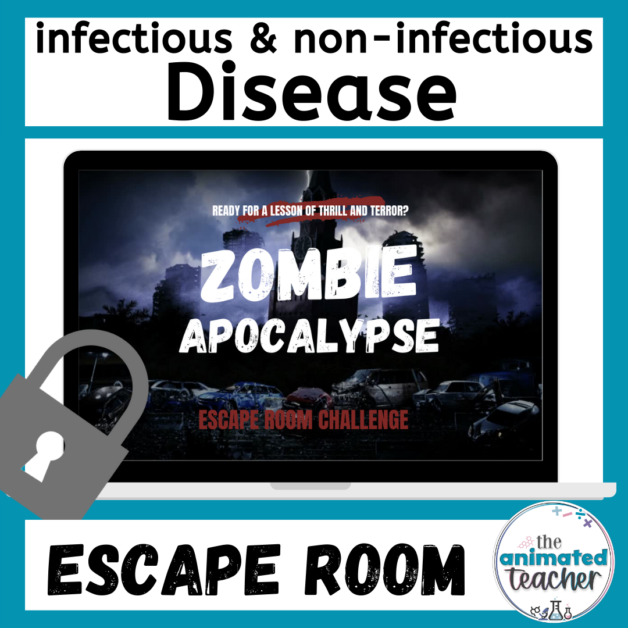AI in High School Science: Teaching Ethical Uses of Chat GPT
Hi science educators! I am very excited to introduce you to this weapon science educator, Alyse from Keystone Science. She has written this amazing guest blog post on how to teach ethical uses of Chat GPT and AI in high school science. In this blog post she delves into how student learning can be impacted by the use if AI, ethical issues around the use of AI, and how these new technologies can be harnessed for their benefit with specific reference to science teaching.
Whether we like it or not, it is likely that AI will forever be entwined in the future of education so its important we learn how to work with it rather than against it.
So grab a coffee, sit back and relax while Alyse steps you through some important ideas and shares a full lesson plan for you!
AI in high school science

Disclaimer: This blog post, ‘AI in high school science‘, may contain affiliate links. Read full disclaimer here. activ
Why Teach AI in High Schools?
- Future-Ready Skills: AI technology is becoming a crucial part of many fields, from healthcare to finance. Understanding AI can provide students with a competitive edge in their future careers.
- Critical Thinking: Learning about AI encourages students to think critically about technology and its impacts on society.
- Ethical Awareness: Introducing AI in the classroom allows for discussions on ethical considerations, including plagiarism and academic integrity.
- Time Management & Study Skills: AI can assist students with managing their time, create study plans, and help them prioritize their responsibilities. Students can also use AI to help them review concepts by acting as a tutor.
AI in high school science
Resources for using AI in high school science
I am by no means the expert on AI and using it in the classroom but I’ve used the lesson in this post the past 2 years with my high school biology students. Students love it and constantly thank me for teaching them more about AI, how it works, and how they can use it.
MOST of my students say before my lesson on AI they had so much anxiety over using AI they just didn’t use it at all because they were terrified of “getting caught” or using it the wrong way. Knowledge is power and this tool is NOT going away.
As a teacher, you do not need to be an expert in anything (yes, even your subject matter) but the lesson outlined below will go much more smoothly if YOU have personally played around with Chat GPT and other AI tools; before doing this lesson it would be beneficial for you have a prompt that gives you bad information that you can show your students some of the silly mistakes AI can make (ask it to explain a human body system…it has given me answers that leave out an entire organ!). I refer to the resources below during the lesson and show the Plagiarism Spectrum from turnitin.com to my students.
- Sal Khan’s (founder of Khan Academy) TED Talk on How AI Could Save (Not Destroy) Education. This is an incredible preview of the potential of AI for students and teachers; if you want to learn more about Conmigo from Khan Academy and the potential for AI in the classroom, check out Sal Khan’s brand new book: Brave New Words: How AI Will Revolutionize Education (and Why That’s a Good Thing) using my affiliate link.
- The chatGPT for Teachers Facebook Group has almost 500k members and a ton of helpful posts and graphics. It’s also a good place to post what you need help with; there are so many knowledgeable people in this space!
- TurnItIn Plagiarism Spectrum (original and 2.0) is just a good review for students of what plagiarism is and why academic integrity is important. Neither specifically includes using AI in the writing process but it’s a great discussion point to have with students; ask them where they think AI use falls on the spectrum.
- TurnItIn’s Solving the AI Writing Puzzle interactive graphic is meant only for teachers and administrators and is an awesome tool for concerns you or administrators have with students using AI and how to guide students to use it ethically and still generate original thought.
Now, without further ado, below is my 45-minute lesson plan to introduce Chat GPT and AI to high school students in a science classroom. You can get your own editable copy of the Canva presentation here.
AI in high school science
AI in high school science lesson plans
Below is a full lesson plan you can use in secondary schools for high school and middle school students to teach them about AI and academic integrity by answering some important questions and helping students gain a better understanding of what AI is and helpful applications of ai.
Objective: Students will understand the basics of AI, specifically Chat GPT, learn about plagiarism and cheating in an academic setting, and ways they can ethically use AI to save time and assist them with their school work.
Materials:
- Teacher computer with a projector or interactive whiteboard.
- Small sticky notes (1.5 x 2 in) for bellringer, dry-erase markers, etc.
- Two different colors of sticky notes (3 x 3 in) for the introduction activity
- Print outs of scenarios in the presentation.
- Individual whiteboards or scrap paper (one per group) for group activity.
Lesson Outline:
- Set up (5 min or less)
- Print out the scenarios on slides 12-15 (one per group)
- Before students enter the room have three columns set up on the board: “Never heard of it”, “Have used it”, “Use it all the time”
- “Bellringer” slide should be displayed as students enter the room.
- Bellringer (as students enter the room)
- Give each student a small sticky note as they enter the room OR have them write a ✅ on the board with a dry-erase marker.
- Students will place their sticky note or write a ✅in the column that best applies to them and their knowledge of ChatGPT or other AI tools.
- Pre-assessment/Activate Prior Knowledge (5-7 minutes)
- Give each student a 3×3 sticky note and show the “Before We Begin” slide.
- Give students a few minutes to write their thoughts and questions on their sticky notes.
- NOTE: Consider doing this the day before the lesson so you know where your class is and what questions they have. Each class may be different and you can adjust the lesson to fit each class’s needs!
- What is Chat GPT? (10 minutes)
- Move through slides 4-9 of the presentation explaining the basics of Chat GPT.
- Pause at slide 9 to answer any questions students may have. This is also a great spot to address some questions from the sticky notes if students don’t have questions.
- Responsible Use & Critical Analysis Group Activity (15-17 minutes)
- Distribute the scenarios on slides 12-15, one per group.
- Give students 5-7 minutes to read the scenario and answer the questions on slide 11. Groups may write their answers on a whiteboard or scrap piece of paper.
- Show the scenario slides and have the assigned group explain their answers to each scenario (~2 minutes per group).
- Academic Integrity Class Discussion (7 minutes)
- Discuss academic integrity as it relates to Chat GPT and AI (slide 16)
- Optional: Give students the TurnItIn Plagiarism Spectrum to refer to as they analyze the three scenarios.
- Go through each of the scenarios on slides 17-19. For each scenario ask the class how the student is utilizing the technology and where their use falls on the academic integrity spectrum.
- Think, Pair, Share (4 minutes)
- Give students one minute to jot down some ideas to use Chat GPT when working on projects or studying for quizzes/tests.
- Give students one minute to discuss their ideas with a partner and identify at least one to share with the class.
- Take 2 minutes to whip around the room to share ideas. As students share, jot ideas on slide 21 or the board.
- Optional: Take a picture of the board or screenshot the slide and post it on your LMS or class site for students to refer to throughout the school year.
- Class Discussion & Ticket Out the Door (4-10 minutes)
- Open the floor for any questions or discussions students want to have about the technology.
- If time is left in the period, consider showing students how Chat GPT works by pulling it up on the board and typing in some prompts.
- Disclosure: Many AI tools have an age requirement or parental permission requirement. I do not allow students to personally use the tool in class unless they have parent permission.
AI in high school science
Now that your students have a better understanding of the ethical uses of AI in high school science to enhance their learning, what about you?! Teachers are BUSY and most struggle to get everything done. I’ve got another blog post you should check out: how to differentiate using AI. The post gives you practical steps and advice on using Diffit and Eduaide (artificial intelligence tools) in your classroom with some freebies (of course!).
AI in high school science
Conclusion
Teaching the use of artificial intelligence and machine learning in high school science is not only about preparing students for future careers but also about fostering critical thinking and ethical awareness. By introducing AI in high school science through hands-on activities and discussions on plagiarism and academic integrity, we can help students navigate the complexities of these technologies responsibly.
If you’re looking for more resources or ideas on using AI in the classroom, be sure to check out my blog and follow me on Instagram (@keystonesciencepa), where you’ll find practical tips and levity from a secondary science teacher who is on this adventure with you. AI in high school scienceAI in high school science
About the Author










